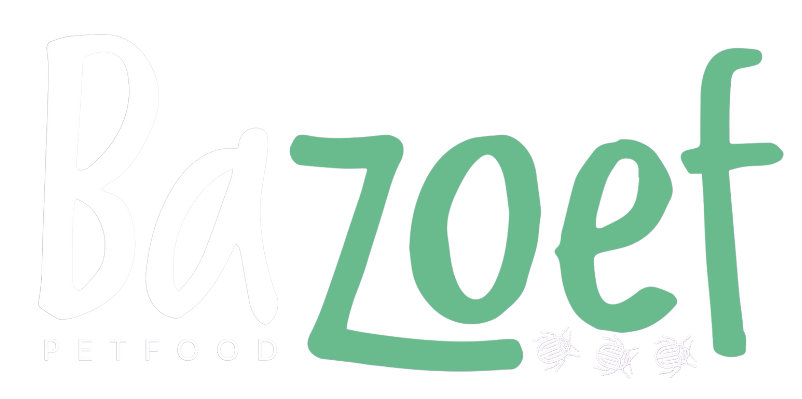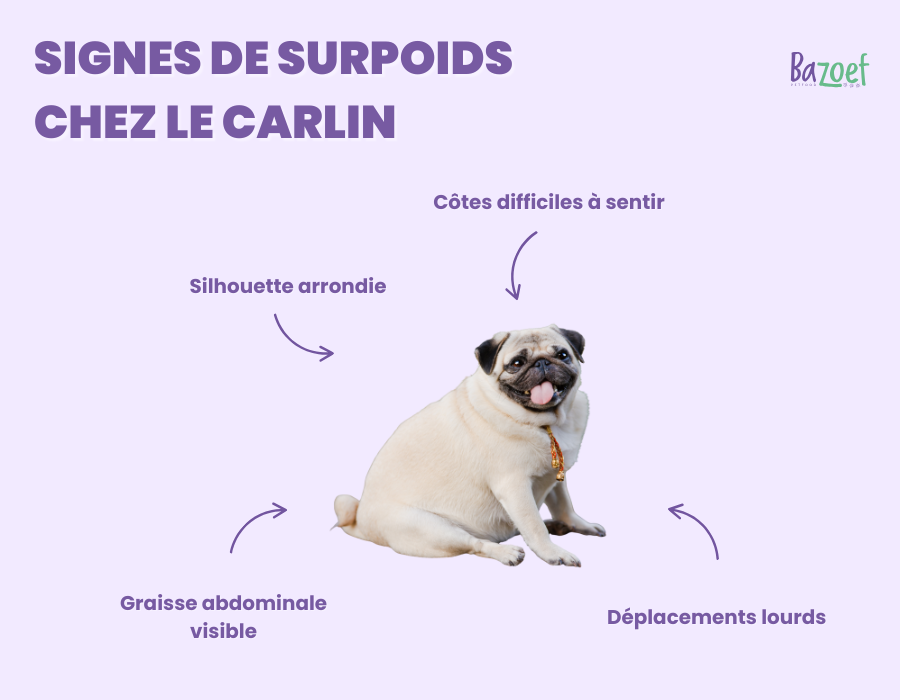With their big eyes and irresistible charm, Pugs are beloved companions — but they’re also one of the breeds most likely to gain weight.
Their tendency to store fat, combined with a strong appetite and relatively low exercise tolerance, makes them especially prone to putting on extra pounds, sometimes even early in life.
The good news is that weight gain isn’t unavoidable.
By carefully controlling portions, limiting treats, and making sure a Pug gets daily activity suited to its needs, you can help keep them fit.
A high-quality diet designed for their ideal weight, along with regular short walks and play sessions, is often enough to maintain a healthy shape.
This guide will show you how.

Is My Pug Overweight?
Weight alone doesn’t give the full picture — a Pug may look “round” because of its compact build, not just because of fat.
To properly assess your dog’s body condition, you need to combine simple visual and hands-on checks you can easily do at home.
The Body Condition Score (BCS) — a method vets use to evaluate whether a dog is underweight, overweight, or in ideal shape — is especially important for Pugs, since they are very prone to obesity and related breathing or joint issues.
📊 Below is a table showing the BCS scale adapted for Pugs:
| BCS Score | Body Condition | Description for Pugs |
| 1–2 | Severely underweight | Ribs and spine very prominent, loss of muscle, no detectable fat |
| 3 | Underweight | Visible ribs, very tucked waist, little muscle mass |
| 4–5 ✅ | Ideal weight | Ribs can be felt under a thin fat layer, slight waist visible from above, gentle tuck at abdomen |
| 6 | Slightly overweight | Light fat cover over ribs, waist barely visible |
| 7 | Overweight | Ribs hard to feel, rounded shape, belly sagging |
| 8 | Significantly overweight | Noticeable abdominal fat, no waist, fat deposits around neck or chest |
| 9 | Severely obese | Heavy fat deposits, labored breathing, difficulty moving |
How to Assess Your Pug’s BCS at Home
- Feel the ribs: they should be felt under a thin layer of fat, not hidden under padding.
- Look from above: there should be a slight waist behind the ribs, even if less pronounced than in longer-bodied breeds.
- View from the side: the belly should rise slightly toward the hind legs, not hang level with the chest.
- Check the base of the tail and neck folds: there shouldn’t be excessive fat or thick rolls.
👉 A BCS of 4 or 5 is ideal for an adult Pug.
At 6, it’s time to adjust food portions and activity.
At 7 or higher, veterinary guidance is strongly recommended.

How Much Should My Pug Weigh?
A Pug’s weight changes as it grows, before stabilizing in adulthood.
Because this breed is especially prone to gaining extra pounds, keeping track of weight from an early age is essential.
Regular monitoring helps prevent obesity, which can worsen breathing problems, strain joints, and increase the risk of metabolic disease.
📊 Here’s a guideline table showing average weights at key life stages for male and female Pugs:
| Age | Average Weight Male | Average Weight Female |
| 2 months | 1.5 – 2.5 kg | 1.3 – 2.3 kg |
| 4 months | 3 – 4.5 kg | 2.8 – 4.2 kg |
| 6 months | 5 – 6.5 kg | 4.5 – 6 kg |
| 9 months | 6 – 7.5 kg | 5.5 – 7 kg |
| 12 months (1 yr) | 6.5 – 8.5 kg | 6 – 8 kg |
| 18 months (adult) | 6.5 – 9 kg | 6 – 8.5 kg |
| Senior (7+ yrs) | Variable (maintain healthy shape) | Variable (maintain healthy shape) |
These figures are averages; the most important measure is your Pug’s body condition score (BCS), not just the number on the scale. A healthy Pug should have a visible waist when viewed from above and ribs that can be felt under a thin layer of fat.
🔎 Note: These values are only guidelines and can vary depending on a Pug’s lineage, activity level, and individual build.
What matters most is your Pug’s overall body condition (see “Body Condition Score”), not just the number on the scale.
Tips to Prevent Your Pug from Becoming Overweight
1. Adjust portions to their ideal weight
Feed your Pug according to their target healthy weight, not their current weight if they are already overweight.
Always measure food with a kitchen scale rather than a scoop or cup, which can easily lead to overfeeding.
2. Split meals
Divide the daily allowance into two or even three smaller meals. This helps digestion, reduces begging, and prevents overeating in a single sitting.
If your Pug eats too quickly, use a slow-feeder bowl or scatter food in a snuffle mat to encourage slower, calmer eating.
3. Avoid table scraps
Human foods like bread, cheese, or cured meats are too fatty and salty for Pugs.
Even a small piece of pizza or cheese can equal a heavy fast-food meal in canine terms. Avoid feeding from the table to prevent unhealthy weight gain and begging behavior.
4. Choose healthy treats
Opt for light, low-calorie options such as small pieces of carrot, zucchini, cucumber, or apple (without seeds).
Use treats sparingly, and remember to include them in the total daily calorie count.
5. Keep them active
Pugs don’t need as much exercise as large breeds, but daily activity is still essential. Aim for two or three short walks (10–20 minutes each), combined with play sessions indoors.
Because of their flat faces, avoid intense exercise in hot or humid conditions. Puzzle toys, scent games, and gentle training are excellent ways to keep them mentally stimulated and burn calories safely.

Examples of Healthy Foods for Pugs
Feeding your Pug a balanced diet starts with selecting ingredients that are easy to digest, nutrient-dense, and supportive of weight management.
Because Pugs are prone to obesity and digestive sensitivities, foods should provide satiety without unnecessary calories, while also supporting skin and coat health.
Some ingredients, like insect protein or pumpkin, are especially beneficial because they combine digestibility with valuable nutrients.
📊 Here’s a table with practical examples of healthy foods suitable for Pugs:
| Ingredient | Nutritional Benefits |
| Insect protein | Highly digestible, rich in essential amino acids, hypoallergenic, low in fat |
| Hull-less oats | Whole grain, soluble fiber, filling, supports steady energy release |
| White rice | Easily digestible carbohydrate, gentle on sensitive stomachs |
| Peas | Plant protein and fiber, helps regulate digestion |
| Rapeseed (canola) oil | Balanced omega-3 & 6, promotes healthy skin, coat, and cardiovascular health |
| Dried pumpkin | Gentle fiber source, supports digestion and stool regularity |
| Dried chicory root | Natural prebiotic (inulin), maintains healthy gut microbiome |
| Brewer’s yeast/extract | Source of B vitamins, boosts coat health and immune function |
| MOS (prebiotics) | Supports gut health, limits harmful bacteria |
| Dried carrots | Rich in beta-carotene (vitamin A), natural antioxidant |
| Dried apples | Provides fiber and mild natural sweetness without excess calories |
| Cranberries | Natural antioxidant, supports urinary health, low in sugar |
A healthy diet for Pugs can combine these ingredients in the right proportions to provide complete nutrition without overloading calories.
This recipe is especially well-suited for Pugs that are overweight or have sensitive digestion, as it limits excess fats, provides filling fibers, and uses highly digestible protein sources to support both weight control and gut health.

It can be served as a complete meal or used as part of a transition toward a more natural or targeted diet (digestive support, weight management, hypoallergenic).
Consequences of Overweight in Pugs
Being overweight is more than a cosmetic issue — for Pugs, it can lead to serious and lasting health problems that affect both comfort and longevity.
Here are the main risks to be aware of:
1. Breathing difficulties and exercise intolerance
Because Pugs are brachycephalic (short-nosed), excess fat around the chest and neck makes breathing even harder.
An overweight Pug may wheeze, snore loudly, and tire quickly after only a short walk, reinforcing a cycle of inactivity.
2. Joint and mobility problems
Even though Pugs are small, extra weight places stress on their hips, knees, and spine.
This can trigger or worsen conditions such as patellar luxation, arthritis, or chronic lameness.
3. Higher metabolic risks
Overweight Pugs are more likely to develop diabetes, hormonal disorders like hypothyroidism, or heart disease.
These conditions often require lifelong management and medication.
4. Shortened lifespan
Studies show that obese dogs may live up to 2 years less than their leaner counterparts.
For Pugs, this means reduced quality of life, more frequent vet visits, and greater discomfort in daily activities.
5. Weaker immune system and inflammation
Excess fat tissue promotes chronic inflammation, which weakens immune defenses and makes Pugs more prone to infections, skin fold irritations, and slower recovery after illness or surgery.

Simple Activities to Help Your Pug Burn Calories
Pugs may be small, but without enough activity they can quickly slip into a sedentary routine and gain weight.
To prevent obesity (or to support weight loss), it’s important to provide short, gentle activities suited to their breathing capacity, age, and overall condition.
You don’t need long workouts — several short sessions each day can make a big difference.
📊 Table: Fun, calorie-burning activities for Pugs
| Activity | Suggested Duration | Benefits |
| Short, brisk walks | 10–20 min, 2–3×/day | Gentle calorie burn, supports mobility, strengthens your bond |
| Indoor play (toys, fetch) | 10–15 min | Light cardio, mental stimulation, safe in hot or humid weather |
| Snuffle mat / scent games | 10 min | Mental enrichment, slows eating, curbs boredom snacking |
| Puzzle toys | 10–15 min | Keeps them occupied, burns calories through mental effort |
| Gentle stair climbing* | 5 min | Builds muscle tone, light cardio (only if joints are healthy) |
| Training sessions | 5–10 min | Reinforces obedience, provides mental and physical stimulation |
*Avoid stairs if your Pug has joint or breathing problems.
💡 Tip: Several short sessions throughout the day are far more effective (and safer) than one long, exhausting activity. Consistency is key.
Conclusion
Feeding your Pug properly goes beyond filling the bowl — it’s a daily commitment to their health, mobility, and comfort.
Affectionate yet prone to weight gain, Pugs need a carefully balanced diet, regular weight checks, and gentle daily exercise.
Whether you choose high-quality kibble, a carefully formulated homemade plan, or a mixed approach, the essentials stay the same: quality, moderation, and consistency.
By keeping a close eye on your Pug’s weight, appetite, energy, and digestion, you’ll help them live a longer, healthier, and happier life by your side.
And remember: the best diet is the one tailored to your Pug’s individual needs — not just what works for other dogs.
Sources
- FEDIAF – European Pet Food Industry Nutritional Guidelines — full guideline for nutritionally balanced pet food in Europe.
- AAFCO – Dog and Cat Food Nutrient Profiles — sets standards for “complete & balanced” pet foods in the US.
- WSAVA – Global Nutrition Toolkit — guidance on selecting pet foods and assessing whether they meet nutrient profile standards.



